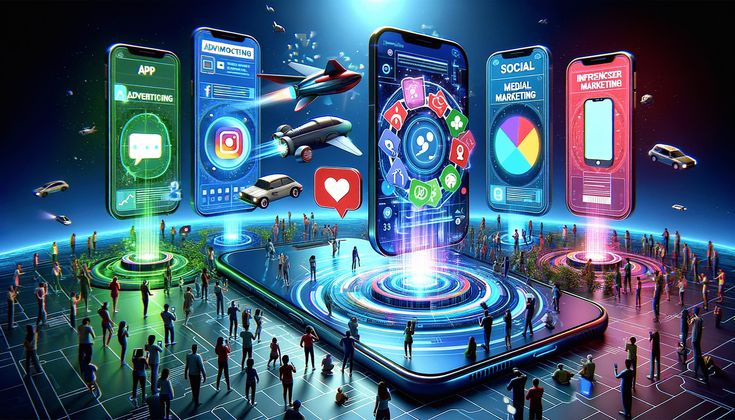The future of mobile advertising is exciting and shows how technology and customer behaviour are changing continuously. Mobile advertising has grown from a few simple banner ads to sophisticated, personalized experiences. With the growing importance of smartphones in daily life, every brand wants to creatively reach and engage users. In this post, we’ll delve deeper into the future of mobile advertising by looking at some of the key trends, technologies, and strategies framing this fast-moving space.

The Evolution of Mobile Advertising
Mobile advertising has evolved in the last decade. The mobile ads, initially, were pretty simple and intrusive; hence, the response rate for them used to be pretty low. However, several technological developments and deeper knowledge of user behavior have helped gain better ad formats. The future of mobile advertisement is based on this groundwork—the new technologies and data-driven strategies that will create more meaningful interactions between brands and consumers.
Personalization and Data-Driven Advertising
The single most prominent trend in mobile advertising is personalization. With massive amounts of data at their command, advertisers can make very targeted campaigns that stay relevant at a user level. This trend is expected to further continue with increasing sophistication in data analytics and machine learning algorithms.
Personalized advertising is more likely to arrest user attention and drive engagement. For instance, analyzing user behavior tells one when the best time to post advertisements is, the kinds of content that users are interested in, and even ad formats preferred by them. This depth of personalization improves the user experience and maximizes returns from advertising campaigns.

Rise of Interactive, Rich Media Ads
With the enhancements to the power of mobile devices, mobile advertising capabilities expand. It has become more frequent to view interactive and rich media advertising—ads that can deliver some type of immersive experience beyond static pictures and text. These range from video to animations and many other elements that engage users in different ways.
For example, AR ads allow a user to interact with a product virtually. Such ad format offers a much more interactive and engaging experience, and due to its memorability, conversion rates may be higher. With the advancement in technologies like AR and VR, we are sure to see many more innovative ad formats that merge digital and physical worlds.
Programmatic Advertising and Automation
Programmatic advertising is a method of buying and selling ad inventory programmatically, using automated procedures, in real time. The technology automates the procedure of advertising, hence making it efficient and cost-effective. It also allows for more precise targeting since it is guided by data on the best ad placements.
In the future, mobile advertising will hugely be based on programmatic advertising; this is so because there is a general increase in the availability of data and a subsequent surge in Artificial Intelligence, AI. The Artificial Intelligence analyzes vast data volumes to squeeze out trends and further optimizes ad campaigns so that the right Ad reaches the right target at the right time.

In-App Advertising and Mobile Commerce
Another large growth area is in-app advertising. As users become more and more engaged with mobile apps, so too are the opportunities for advertisers to reach those users within their favorite apps. Because in-app advertising can be much more targeted and seamlessly integrated into the app experience, it is much less intrusive and more engaging.
M-commerce, too, is on the rise. As consumers are more and more turning to their smartphones for online shopping, advertisers have started laying emphasis on developing seamless shopping experiences within mobile applications and websites. It comprises personalization of product recommendations, easy checkout options, and mobile-friendly payment solutions.
The Need for Privacy and Transparency
The more mobile advertising becomes sophisticated, the more concerns about privacy and data security increase. Consumers become very aware of exactly how their data is being used and they want transparency and control over it. Advertisers will have to reassure that privacy is their number one priority and that they are compliant with regulations concerning it, like the General Data Protection Regulation and the California Consumer Privacy Act.
Very soon, the mobile advertisements will be living the sensitive dance between personalization and privacy. Advertisers have to be clean of heart in relation to data collecting practices and give users clear possibilities regarding their data control. Long-term success for mobile advertising is connected with building trust with consumers.

The Role of 5G Technology
The coming rollout of 5G technology may drive a sea change in mobile advertising. Increased speeds and lower latency mean 5G will support far more immersive, interactive ad experiences. For example, high-quality video ads can be streamed in seamlessly, while AR/VR experiences can be delivered without lag.
5G also fuels the growth in the Internet of Things, further bridging connectivity between devices and creating more spaces for ad placements. Advertisers can tap into IoT data in streaming highly relevant ads in real-time context. For example, when smart refrigerator sensors pick up that supplies are low, it could stream ads for groceries.

The Shift to Video and Social Media
Video content continues to dominate mobile consumption, and it is also where most advertisers are capitalizing. YouTube, TikTok, and Instagram are leading platforms that provide a strong opportunity for video advertising. Short-form videos, live streaming, and user-generated content have shown huge potential in capturing user attention.
Social media also holds a very important role in the future of mobile advertisement. Since social media provides more ways to target and engage with the target audience for the campaigns, it will provide more room for improvement by advertisers. Influencer marketing is a powerful tool, and because of this, influencers can create authentic connections with their followers and promote products in a relatable way.
Conclusion:
The future for mobile advertisement is bright, powered by technology and shifting consumer behaviors. Major trends forging this future include personalization, interactive/rich media ads, programmatic advertising, in-app advertising, and more. With 5G technology becoming all-pervasive, we can expect even more innovative ad formats and seamless experiences.
With great power, however, comes great challenges. Privacy concerns and the need for transparency are at the forefront, and advertisers must be very cautious to instill trust with the consumer. Focusing on user experience and the latest technologies can enable effective, engaging mobile ad campaigns that really drive results in a changing digital landscape.
Basically, the future of mobile advertisement will be all about creating users who undergo meaningful experiences and personalization. The more advanced technology gets, the more options advertisers will have to reach their audiences in the most innovative and powerful ways possible. Staying at the very forefront of trends and respecting the privacy of users are among the things that can potentially help any advertiser succeed within the competitive environment of mobile advertising.
To give growth to your business with mobile advertisement visit


